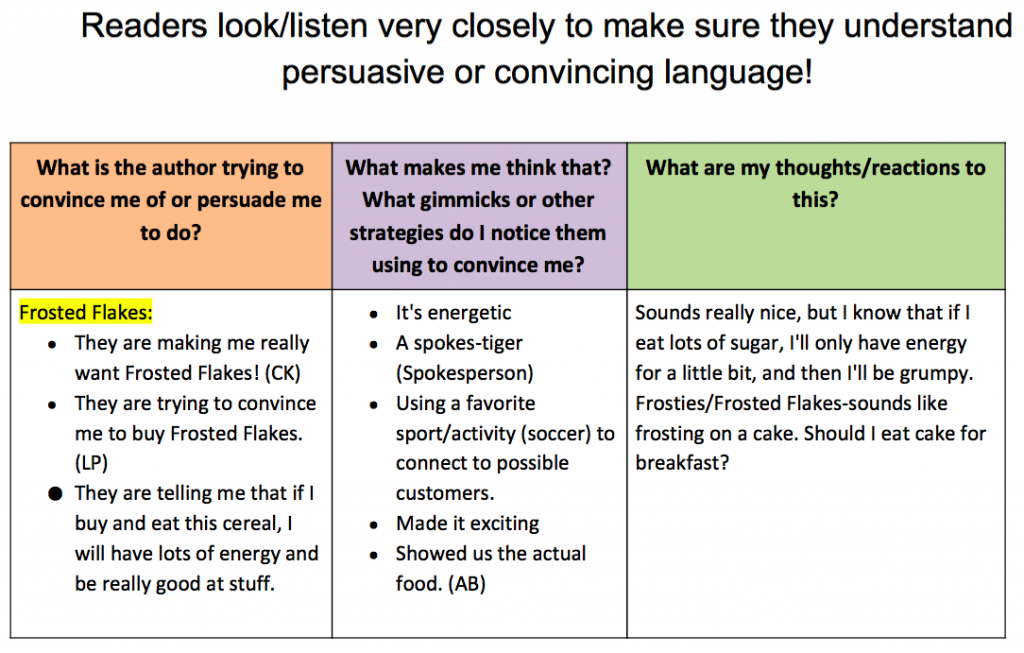Two weeks ago, my fourth graders began an inquiry into the use of persuasive language in our reading workshop. This, of course, as a part of our unit of inquiry into “how we organize ourselves.” Armed with three essential questions for reading or listening to persuasive language closely and critically, we’ve explored print ads, commercials, picture books with persuasive characters, news articles, book reviews and editorials.
The world is filled with persuasive language, and curating a collection which models this type of language in the form of texts and videos is a challenge. One must consider the prior experiences of the students, their reading abilities, and their interests; not to mention teaching and learning goals. I set off preparing for this unit with the goal of having a collection of persuasive language that was large enough and broad enough to meet the needs and interests of my diverse class.
Commercials:
Our first entry into the world of persuasion was with t.v. commercials. I set up a youtube account with a collection of age-appropriate commercials that advertised products in different areas around the world. You can read more about these and the first phase of this unit in my last blog post.
Print Advertisements:
In order to find a selection of print advertisements, I started from scratch. I googled “print advertisements.” This was more successful than I anticipated, but I quickly found that I could search “best print ads of 2015,” and “best international advertisements.” These led me on a path to dozens of fourth-grade appropriate, culturally diverse advertisements. I purposefully chose a selection of ads which had a variety of purposes, ranging from selling goods, to don’t text and drive, to campaigning for the environment. We started off together, analyzing a print advertisement advocating for the ocean environment.
I chose this advertisement as our shared piece for several reasons. First, it was published in quite a few languages-same advertisement, different language. While we discussed the English version of the advertisement, native speakers of Spanish, Italian and Korean were also able to explore it in their mother tongue. Second, there were multiple messages in this advertisement, ranging in complexity. This would allow the students who needed more practice with identifying the purpose a point of entry, while allowing for more deeper exploration for those students ready for a challenge. I noticed more students were participating in the analysis than in previous days, using the three questions. Still, some found this type of thinking to be overwhelming and needed more support-my first strategy group for this unit! After our shared practice, students were sent off with the choice to look at other print ads in the collection I’d created, or going back to look at more commercials on our youtube channel.
Stories With Characters Using Persuasive Arguments:
This was the easiest preparation for me. I already had a collection of picture books from previous years. Some of my favorite titles include: Hey, Little Ant, by Phillip M. Hoose, My Brother Dan’s Delicious, by Steven L. Layne, Earrings, by Judith Viorst, Can I Keep Him?, by Steven Kellogg, and the I Wanna books, by Karen Kaufman Orloff. The kids love all of these books and they serve as powerful mentor texts down the line in writer’s workshop. If you know of other great mentor texts, please let me know!
News Articles/Editorials/Blogs:
My students have already been exposed to book blogs and book reviews from our “Readerly Life” unit. I used a review from this mother and son blog, giving students more exposure to how we use persuasive language, but also letting them see the role of multiple perspectives. I found a bunch of editorials, articles and reviews, mostly by luck and perseverance on the internet. I also trolled Newsela, and made a collection of opinion articles for kids. This is where I got the bulk of my articles. If you don’t know Newsela, I highly recommend you check it out. It’s a free source for news articles for students of all ages. It’s a very user-friendly, searchable site and you can create digital collections online, saving the articles you want to use for a given purpose. The articles are available on multiple reading “levels” so that students can find a just right version to read. There are even more perks to this site, but I haven’t used it to it’s fullest potential yet. (How am I doing with my use of persuasive language in this section?)
I printed out copies of every article I used. My students have access to the websites, but during reader’s workshop I prefer that they can interact with the print, old-school style. I’m not yet convinced that reading online supports close or critical reading, and I like that students can mark up the texts. I’m open to discussion on this, so go ahead and do your best to persuade me otherwise;-).
So, another week has passed, and my readers are becoming increasingly close readers of, and listeners to, persuasive texts. Through mini-lessons and guided practice, they have learned to determine the author or speaker’s purpose, how to identify and consider the reasons the author or speaker gives, and to use their own experiences, knowledge and understandings to think critically about the author or speaker’s perspective or goal.
On Monday, we launch our focus on persuasive language in our writer’s workshop!
